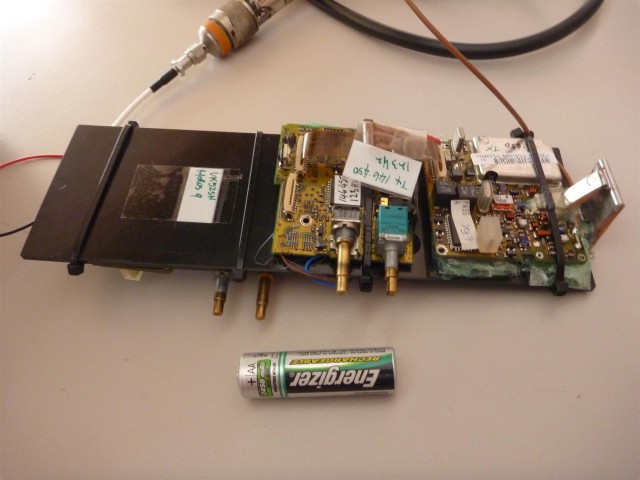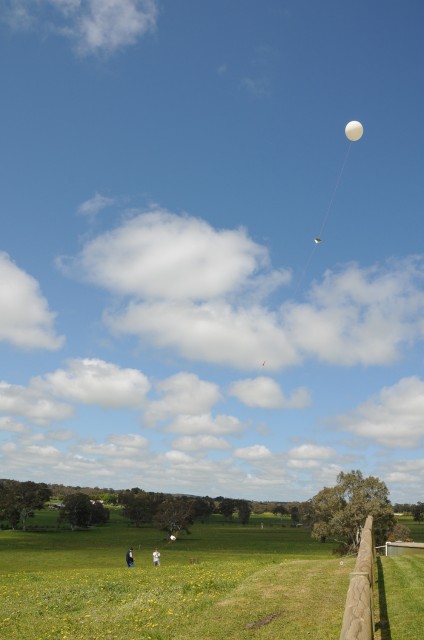The story behind Horus 8
Grant VK5GR has put together an excellent little documentary covering the launch of Horus 8 - this features both footage from the onboard camera, and footage he shot at the launch and landing sites. I'm sure you'll agree that this is a great little piece of film, and Grant assures us there's more to come yet! ![]()
Grant has put together a few videos for the project now, including a time lapse video of the stills from Horus 7, and the onboard footage from Horus 8. For more of his work, checkout his Vimeo page.
Launch of Horus 9
The flight of Horus 9 on 23/10/10 was a great success - all payloads worked as hoped, and a great number of people were able to make contacts via the repeater. The payload landed in the scrub of Billatt conservation park - fortunately near a track (1km out in the scrub) which meant we were able to recover it without too much fuss.
A big thanks to all involved - we really couldn't have done it without you!
I've put the writeup online, though it's not yet complete - it's missing the list of contacts logged, as well as recovery pics (I'll put these online very soon!) ![]()
Upcoming launch: Horus 9
Horus 9 is currently set for launch on Saturday the 23rd of October 2010. The launch has been timed to coincide with the WIA national field day, the aim of which is to promote public awareness of amateur radio.
Horus 9 will be flying several payloads:
- Horus flight computer & telemetry
- APRS beacon (callsign VK5ZSN-11)
- Talk through cross band repeater (public use)
- Simplex repeater (tracking & team use)
Launch time is expected to be 01:30 UTC, 23/10/10.
As usual, the balloon will be trackable online at http://spacenear.us/tracker. For those wishing to follow via APRS, you can follow the balloon online at http://aprs.fi or similar.
The talk through cross band repeater details are as follows (CTCSS is mandatory):
Input: 438.900 MHz (CTCSS 123Hz)
Output: 146.450 MHz (CTCSS 123 Hz)
We'd like to invite anybody who can talk through the cross band repeater to do so - we'll be sending out QSL cards to all contacts logged again as we did when Horus 6 flew. Repeater coverage is expected to be approx 800km radius at apogee - encompassing most of South Australia and Victoria. Net control will be maintained by Adrian VK5ZBR & Rod VK5UDX.
If you are able to help with decoding telemetry, please shoot me an email and I'll forward you the simplex repeater details so you can stay in touch with a chase cars + launch site/control.
Project Horus: 1 Year!
It's been one year today since projecthorus.org went online. 8 flights later, I've certainly learned a lot, met some great people & had a bunch of fun! ![]()
This seems like a fitting time to announce a couple of upcoming launches:
Lonely Planet:
I'm currently working with Melbourne artist Chris Lansell in conjunction with Tony Wheeler of Lonely Planet on a project involving HD video cameras & lots of altitude. At this stage, the project is looking like 2 launches, one carrying several HD video cameras, the other carrying still photography. Lift off is set for mid November, weather permitting!
Jason Hansma:
I've been approached by Dutch artist Jason Hansma to assist him in launching one of his exhibitions to near-space. Jason's based in Perth at the moment, and is working on a concept of launching a sculpture of Hermes (the messenger of the gods) into space, capturing the journey in HD video.
There's even more in the pipeline too.. keep your eye on the blog for updates soon. ![]()

Launch Recovery of Horus 8
This weekend saw the launch of Horus 8 - due to an error in balloon inflation, this flight went for much longer than expected, and ended up landing in the sea at Carrickalinga!
I've put the full writeup of the flight online here. This was without doubt the most challenging recovery we've had to deal with so far - a big thanks to all who were involved this weekend. ![]()
Horus 9 was unfortunately postponed due to poor weather, and of course the damage to the Horus 8 payload.
Weekend of launches: Horus 8 Horus 9
Weather predictions current suggest that Saturday the 9th of Oct is looking like an ideal day for launching. Whilst it's not quite the 10/10/10 we wanted to launch on, we can't pass up such great conditions - so we're going to go ahead and launch Horus 8 on Saturday. Launch time will be around 12:00 local time (GMT +10:30). Horus 8 will be flying a high definition video payload as well as an experimental HF telemetry payload.
Of course, we still want to have a crack at launching on 10/10/10 as part of the One Day on Earth movement, so if conditions permit, we'll be launching Horus 9 the next day - Sunday the 10th of October! We'll be flying the same HD video payload minus the HF telemetry experiment. I'll update the blog to confirm if Horus 9 is flying (including launch time) on Saturday evening.
For those interested in tracking, telemetry (300b RTTY) will be broadcast on 434.650 MHz SSB on both launches. Horus 8 will also include 300b RTTY on HF - 7.037 MHz. You can decode the HF telemetry using exactly the same software (dl-fldigi), you'll just need to select the 'DARKSIDE' payload. Checkout the tracking page for more info.
Both launches will also be flying our simplex repeater, though we'll be using it as a comms platform for our chase teams and trackers rather than as an experiment this time. If you're able to assist with tracking, please contact me to let me know and I'll forward on the comms repeater details so that you can keep in touch with the team. ![]()

